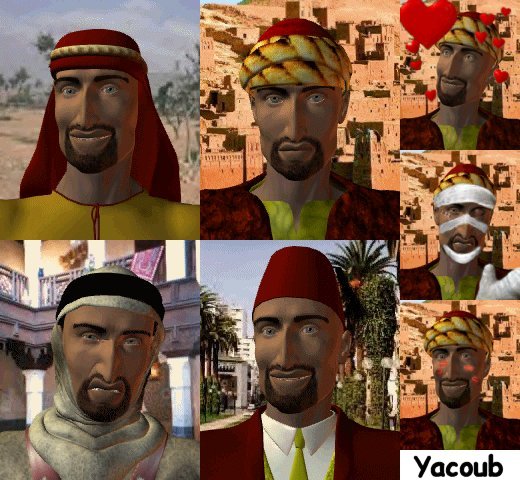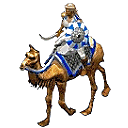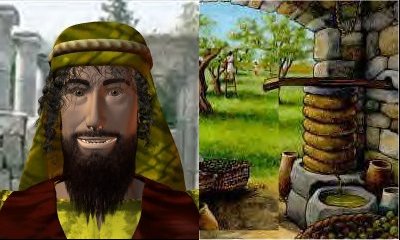Civilopedia information (I obtained this last year and cannot remember the source).
^Unlike other North African nations, Morocco has been largely occupied by one group of people for as long as recorded history can recall.
The Berbers, or Imazighen (men of the land), settled in the area thousands of years ago and at one time controlled all of the land between
Morocco and Egypt. Divided into clans and tribes, they have always jealously guarded their independence. It's this fierce independence that
has helped preserve one of Africa's most fascinating cultures.
^The early Berbers were unmoved by the colonising Phoenicians, and even the Romans did little to upset the Berber way of life after the sack
of Carthage in 146 BC. All the same, the Romans ushered in a long period of peace during which many cities were founded, and the Berbers
of the coastal plains became city dwellers. Christianity turned up in the 3rd century AD, and again the Berbers asserted their traditional dislike
of centralised authority by following Donatus (a Christian sect leader who claimed that the Donatists alone constituted the true church).
^Islam burst onto the world stage in the 7th century when the Arab armies swept out of Arabia. Quickly conquering Egypt, the Arabs controlled
all of North Africa by the start of the 8th century. By the next century much of North Africa had fragmented, with the move towards a united
Morocco steadily growing. A fundamentalist Berber movement emerged from the chaos caused by the Arab invasion, overrunning Morocco and
Muslim Andalusia (in Spain). The Almoravids founded Marrakesh as their capital, but they were soon replaced by the Almohads.
^Under these new rulers, a professional civil service was set up and the cities of Fès, Marrakesh, Tlemcen and Rabat reached the peak of their
cultural development. But eventually weakened by Christian defeats in Spain, and paying the price for heavily taxing tribes, the Muslim (or Moorish)
rule began to wane. In their place came the Merenids, from the Moroccan hinterland, and the area again blossomed - until the fall of Spain to the
Christians, in 1492, unleashed a revolt that dissolved the new dynasty within 100 years.
^After a number of short-lived dynasties rose and fell, the Alawite family secured a stranglehold in the 1630s that remains firm to this day.
Although it was rarely a smooth ride, this pragmatic dynasty managed to keep Morocco independent for more than three centuries.
^Enter the European traders in the late 19th century, and a long era of colonial renovations. Suddenly France, Spain and Germany were all keen
on hijacking the country for its strategic position and rich trade resources. France won out and occupied virtually the entire country by 1912.
Spain clung to a small coastal protectorate and Tangier was declared an international zone.
^Relatively speaking, the first French resident-general, Marshal Lyautey, respected the Arab culture. He generously resisted the urge to destroy
the existing Moroccan towns and instead built French villes nouvelles (new towns) alongside them. He made Rabat on the Atlantic coast the new
capital and developed the port of Casablanca. The sultan remained, but as little more than a figurehead. Lyautey's successors were not so sensitive.
Their efforts to speed French settlement prompted the people of the Rif Mountains, led by the Berber scholar Abd el-Krim, to rise up against both
colonial forces. It was only through the combined efforts of 25,000 Spanish-French troops that Abd el-Krim was eventually forced to surrender in
1926. By the 1930s, more than 200,000 French had made Morocco home. WWII saw Allied forces use Morocco as a base from which to drive the
Germans out of North Africa.
^With the war over, Sultan Mohammed V inspired an independence party which finally secured Moroccan freedom in 1956. Tangier was reclaimed
in the process, but Spain refused to hand over the northern towns of Ceuta and Melilla (to this day they remain Spain's last tenuous claim on
Africa).
^Mohammed V promoted himself to king in 1957 and was succeeded four years later by his son, Hassan II. This popular leader cemented his
place in Moroccan hearts and minds by staging the Green March into the Western Sahara, an area formerly held by Spain. With a force of
350,000 volunteers, Hassan's followers overcame the indigenous Sahrawis to claim the mineral-rich region as their own.
^By the 1960s it had become clear that the 100,000 or so inhabitants of the 'territory' wanted independence. Western Sahara's Popular Front for
the Liberation of Saguia al-Hamra and Rio de Oro (Polisario) didn't take kindly to the invasion and embarked on a long and gruesome war of
independence against Morocco. In 1991, the United Nations brokered a ceasefire and more recently decided to 'remain seized of the matter'.
In other words, Western Sahara's official status remains in question thanks to Morocco's continued muscle flexing. While the Moroccan masses
applauded the southern invasion, it left nearby Algeria about as happy as the Western Saharans themselves. Morocco's relations with this
particular war-torn neighbour have been poor ever since.
^In July 1999 King Hassan II, who had served as absolute monarch (despite recent, semi-democratic changes to the constitution) for 38 years,
was succeeded by his son, Crown Prince sidi Mohammed. King Mohammed VI has promised to purge corruption from the government, allow more freedom
of the press and institute the odd democratic reform just as soon as he gets a chance. A baker's dozen of dad's cronies have indeed gotten the axe, and Mohammed
did pardon a couple of journalists imprisoned for questioning the prime minister's policies, although seven newpapers were subsequently shut down after they mistook
the king's leniency for true editorial autonomy. Much-anticipated democratic reforms are a rocky proposition in this country still stuck in a feudalist rut, but it looks like
the young king may well give it his best shot.





 ?
?

 I'd left it in that order from when it was Queen Teuta!!
I'd left it in that order from when it was Queen Teuta!!I'd left it in that order from when it was Queen Teuta!!


 . It's not real feedback, it just says it's really good.
. It's not real feedback, it just says it's really good. ) members of the community likes my baby
) members of the community likes my baby  .
. ?
?
?

 . I can't do anything else whilst rendering, except wait. So it might be a day or two before you see it.
. I can't do anything else whilst rendering, except wait. So it might be a day or two before you see it.

